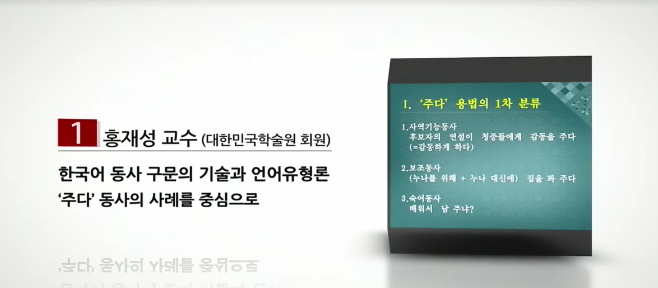“Yu” and “Ci” are respectively used in different areas. “Yu” is used in analyzing sentences and “Ci” is used in classification of words. But many Chinese grammarians use “Dongci” in analyzing sentences. Xing Fuyi pays attention ...
http://chineseinput.net/에서 pinyin(병음)방식으로 중국어를 변환할 수 있습니다.
변환된 중국어를 복사하여 사용하시면 됩니다.
- 中文 을 입력하시려면 zhongwen을 입력하시고 space를누르시면됩니다.
- 北京 을 입력하시려면 beijing을 입력하시고 space를 누르시면 됩니다.
https://www.riss.kr/link?id=A101997516
- 저자
- 발행기관
- 학술지명
- 권호사항
-
발행연도
2016
-
작성언어
Chinese
- 주제어
-
등재정보
KCI등재
-
자료형태
학술저널
- 발행기관 URL
-
수록면
195-209(15쪽)
-
KCI 피인용횟수
0
- 제공처
-
0
상세조회 -
0
다운로드
부가정보
다국어 초록 (Multilingual Abstract)
“Yu” and “Ci” are respectively used in different areas. “Yu” is used in analyzing sentences and “Ci” is used in classification of words. But many Chinese grammarians use “Dongci” in analyzing sentences.
Xing Fuyi pays attention to this phenomenon, and argues that the term of “Dongci” should be replaced by “Dongyu”. Xing Fuyi believes that “Dongyu” is sometimes bigger than a simple verb and it also implies movement or action. Though the term of “Dongyu” is more appropriate than that of “Dongci”, I argue that there are some problems in his viewpoint, because some so-called “Dongyu” don’t imply any movement or action at all.
According to my research, when prepositions are placed behind verbs or adjectives in Chinese, they have the tendency of combining with the prepositioned verbs or adjectives, and role predicates in sentences. Different from “Verbs + prepositions”, “adjectives + preposition ‘Yu’” don’t have any movement or action, so I argue that the term of “Dongyu” is not profitable for these cases. I think that we should adopt the term of “Shuyu” instead, because “Shuyu” isn’t just related to the movement or action, it can also be related to the description about something.
Prepositions have been considered to form the complement with their object, when they are placed after the verbs or adjectives in Chinese. This kind of viewpoint can’t explain the changes in Chinese. In Chinese the prepositions have the tendency of adhering to the verbs or adjectives when they are followed by the verbs or adjectives. In this case I argue that they should be analyzed as “Dongci+Yuzhui” and “Xingrongci+Yuzhui”.
목차 (Table of Contents)
- 1. 引言
- 2. “謂语説”
- 3. “動語說”與“述語說”
- 4. “述語”的特殊類型
- 5. 結論
- 1. 引言
- 2. “謂语説”
- 3. “動語說”與“述語說”
- 4. “述語”的特殊類型
- 5. 結論
- 【參考文獻】
- 【Abstract】
참고문헌 (Reference)
1 邢福義, "語法問題探索集" 湖北教育出版社 1983
2 石聲淮, "語文知識千問" 湖北教育出版社 1985
3 徐公, "詞與短語" 北嶽文藝出版社 2011
4 何善芬, "英漢語言對比研究" 上海外語教育出版社 2003
5 楊自儉, "英漢對比研究論文集" 上海外語教育出版社 1999
6 中國社會科學院語言研究所詞典編輯室, "現代漢語詞典" 商務印書館 2012
7 高更生, "現代漢語知識大詞典" 山東教育出版社 1995
8 張誼聲, "現代漢語副詞探索" 學林出版社 2004
9 钱乃荣, "現代漢語" 江蘇教育出版社 2001
10 鄧丹, "漢語韻律詞研究" 北京大學出版社 2000
1 邢福義, "語法問題探索集" 湖北教育出版社 1983
2 石聲淮, "語文知識千問" 湖北教育出版社 1985
3 徐公, "詞與短語" 北嶽文藝出版社 2011
4 何善芬, "英漢語言對比研究" 上海外語教育出版社 2003
5 楊自儉, "英漢對比研究論文集" 上海外語教育出版社 1999
6 中國社會科學院語言研究所詞典編輯室, "現代漢語詞典" 商務印書館 2012
7 高更生, "現代漢語知識大詞典" 山東教育出版社 1995
8 張誼聲, "現代漢語副詞探索" 學林出版社 2004
9 钱乃荣, "現代漢語" 江蘇教育出版社 2001
10 鄧丹, "漢語韻律詞研究" 北京大學出版社 2000
11 趙傑, "漢語語言學" 朝華出版社 2001
12 高更聲, "漢語語法研究" 山東人民出版社 2001
13 邢福義, "漢語語法學" 東北師範大學出版社 1998
14 毛秀月, "普通語言學綱要" 北京大學出版社 2004
15 房玉清, "實用漢語語法" 北京語言學院出版社 1996
16 陳昌來, "介詞與介引功能" 安徽教育出版社 2002
17 乙武洋匡, "五體不滿足" 山東文藝出版社 2000
18 김종찬, "“雙音節動詞(於)+賓語”探析—以“擅長(於)+賓語”爲例" 한국중국언어학회 (53) : 115-130, 2014
19 김종찬, "“動/形+於”結構新解" 중국어문학회 (47) : 329-343, 2014
동일학술지(권/호) 다른 논문
-
- 한국중어중문학회
- 姜必任(강필임)
- 2016
- KCI등재
-
- 한국중어중문학회
- 당윤희(Dang, Yun-Hui)
- 2016
- KCI등재
-
- 한국중어중문학회
- 김낙철(Kim, Nak-Chul)
- 2016
- KCI등재
-
- 한국중어중문학회
- 김명구(Kim, Myung-Goo)
- 2016
- KCI등재
분석정보
인용정보 인용지수 설명보기
학술지 이력
| 연월일 | 이력구분 | 이력상세 | 등재구분 |
|---|---|---|---|
| 2027 | 평가예정 | 재인증평가 신청대상 (재인증) | |
| 2021-01-01 | 평가 | 등재학술지 유지 (재인증) |  |
| 2018-01-01 | 평가 | 등재학술지 유지 (등재유지) |  |
| 2015-01-01 | 평가 | 등재학술지 유지 (등재유지) |  |
| 2013-05-21 | 학회명변경 | 한글명 : 변화없음 -> 한국중어중문학회영문명 : Korea Association of Chinese Language And Literature -> 미등록 |  |
| 2013-05-21 | 학회명변경 | 한글명 : 한국중어중문학회 -> 변화없음영문명 : The Chinese Language And Literature Society Of Korea -> Korea Association of Chinese Language And Literature |  |
| 2013-05-21 | 학술지명변경 | 외국어명 : The Journal of Chinese Language and Literature -> Korea Journal of Chinese Language and Literature |  |
| 2011-01-01 | 평가 | 등재학술지 유지 (등재유지) |  |
| 2009-01-01 | 평가 | 등재학술지 유지 (등재유지) |  |
| 2007-01-01 | 평가 | 등재학술지 유지 (등재유지) |  |
| 2005-01-01 | 평가 | 등재학술지 유지 (등재유지) |  |
| 2002-01-01 | 평가 | 등재학술지 선정 (등재후보2차) |  |
| 1999-01-01 | 평가 | 등재후보학술지 선정 (신규평가) |  |
학술지 인용정보
| 기준연도 | WOS-KCI 통합IF(2년) | KCIF(2년) | KCIF(3년) |
|---|---|---|---|
| 2016 | 0.32 | 0.32 | 0.26 |
| KCIF(4년) | KCIF(5년) | 중심성지수(3년) | 즉시성지수 |
| 0.26 | 0.22 | 0.575 | 0.12 |





 DBpia
DBpia




